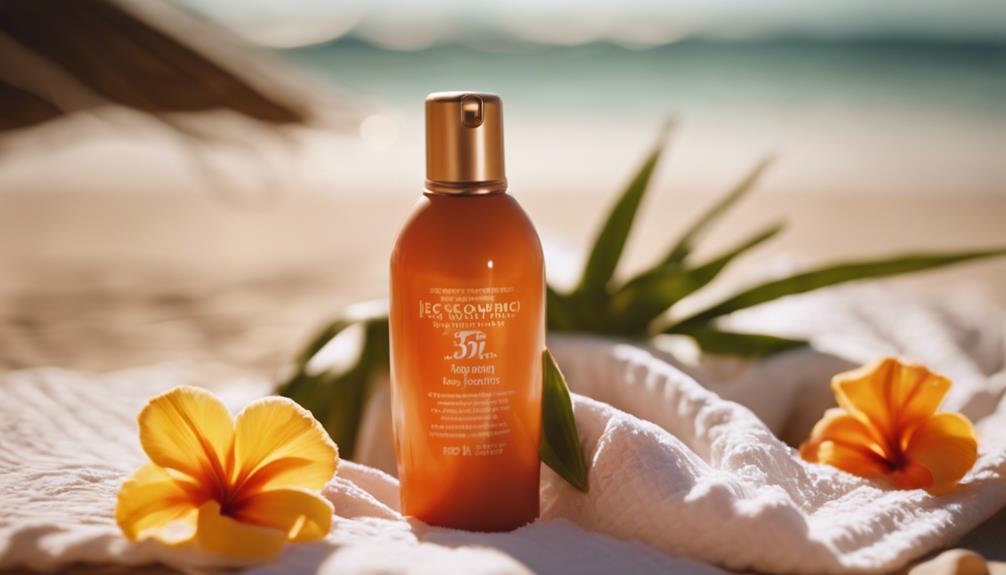You can totally achieve flawless legs with tanning lotions! They give you that sweet sun-kissed glow without the risk of burning. Look for products with hydrating ingredients, like aloe vera, to keep your skin soft and smooth. Don't forget to choose the right shade for your skin tone—you don't want to end up looking like an Oompa Loompa! And remember to exfoliate before applying, so your tan goes on even and streak-free. Got a few more minutes? Stick around, and I'll share even more tips to keep your legs glowing all season long!
Key Takeaways
- Exfoliate before application to ensure a smooth, even finish and prevent uneven patches on your legs.
- Use a tanning mitt for better control and to avoid staining your hands during application.
- Apply lotion evenly, starting from your ankles and working upwards for a natural look.
- Choose a shade that complements your skin tone to avoid unnatural appearances and enhance leg appearance.
Benefits of Tanning Lotions
Tanning lotions offer you a safe way to achieve a sun-kissed glow while nourishing your skin with hydrating and firming ingredients.
You know that feeling when you look in the mirror and think, “Ugh, I need some color”? Well, these lotions can be your best friend! They give you that natural-looking tan without the risk of sunburn or damage.
Plus, who doesn't love a little hydration? With all those moisturizing goodies, your skin feels soft and smooth instead of dry and flaky.
And let's be honest, toned legs look amazing in shorts or skirts, right? So why not skip the sun and grab a tanning lotion?
Your legs will thank you, and you'll rock that glow with confidence!
Key Ingredients for Success

Choosing the right ingredients in your tanning lotion can make all the difference in achieving a flawless, natural-looking glow.
Look for skin-firming ingredients that help smooth out those pesky cellulite bumps—who doesn't want toned legs?
Also, don't forget about hydration! Aloe vera is your best friend here, keeping your skin moisturized while you tan.
Antioxidants are a bonus, fighting off those pesky free radicals that can age your skin.
And let's be real; nobody wants a streaky mess, so opt for gradual tanners that build color over time.
With the right ingredients, you can rock those legs and feel confident, all while avoiding the sun's harmful rays.
Ready to shine? Let's do this!
Selecting the Perfect Shade

Finding the right shade for your tanning lotion is key to achieving a natural, sun-kissed look that complements your skin tone.
If you've got fair skin, go for lighter golden-peach shades; they'll make you look like you just returned from a beach vacation!
Medium skin tones? Richer golden-olive hues are your best buds.
And hey, don't forget about gradual tanners! They let you build color slowly, so you can avoid that “oops, I look like an Oompa Loompa” moment.
Always test a small patch before diving in, just to make sure the shade's right for you.
After all, nobody wants to end up with an unnatural glow that screams “self-tanner!”
Cheers to flawlessly tanned legs!
Effective Application Techniques

For the best results, exfoliate your skin before applying the lotion to guarantee an even, streak-free finish. Trust me; you don't want to end up with a splotchy tan!
Here's how to nail the application:
- Use a tanning mitt: It not only helps you avoid stained hands but also gives you better control.
- Apply evenly: Start at your ankles and work your way up, blending as you go. Think of it as painting—no one wants a mess!
- Let it dry: Give it at least 10 minutes before putting on clothes. You're going for a sun-kissed glow, not a laundry disaster!
Follow these tips, and you'll rock those flawless legs in no time. Who knew tanning could be this fun?
Common Self-Tanner Issues

Self-tanners can sometimes leave you with unwanted orange tones or uneven patches if not applied correctly. Yikes, right? Nobody wants to look like a walking carrot!
Streaking often happens if you rush the application or skip using a mitt. Plus, some products may have scents that aren't the most pleasant—who wants to smell like a tropical fruit salad gone wrong?
And let's face it, the results can vary based on your skin chemistry, which can be super frustrating. To avoid these hiccups, always patch test first and don't overdo it.
You want that sun-kissed glow, not a sunburnt mess! With a little practice, you'll be rocking those flawless legs in no time. Happy tanning!
Product Features to Consider

When selecting a tanning lotion, consider key product features that can enhance your tanning experience and guarantee a flawless finish. You don't want to end up with a tan that screams “I just rolled in a carrot patch,” right? Here are three must-check features:
- Hydration: Look for lotions with aloe vera or other moisturizing ingredients to keep your skin smooth and prevent dryness.
- Quick-Drying Formula: You'll love a lotion that dries fast, so you can get dressed without worrying about stains.
- Shade Compatibility: Pick a shade that matches your skin tone for a natural look; nobody wants to be the awkward orange friend!
Comparing Tanning Products

While exploring tanning products, you'll find distinct differences in formulation and results that can greatly impact your tanning experience.
For instance, bronzers give you instant color but can be a bit tricky—they might streak if you're not careful.
Then there are gradual tanners, which build up your tan over time and often pack in skin-nourishing goodies. Ever tried Jergens Natural Glow? It hydrates while giving you that sun-kissed look!
On the flip side, Sally Hansen Airbrush Legs offers a quick fix without the commitment. It's like magic in a bottle!
Tips for Long-Lasting Results

To keep your tan looking fresh and vibrant for longer, focus on proper skin care and maintenance techniques that enhance your sun-kissed glow. Here are three tips to help you keep that gorgeous color:
- Moisturize Regularly: Hydrated skin holds onto color better, so slather on a good lotion daily. You don't want your legs looking like a raisin, right?
- Avoid Exfoliating Too Much: Exfoliating is great before applying tan, but don't go overboard afterward. It can fade your glow faster than you can say “oops!”
- Reapply Weekly: Keep your tan in check by reapplying your self-tanner every week. It's like giving your legs a little refresher course!
Follow these tips, and you'll be rocking those flawless legs all season long!
Frequently Asked Questions
Can Tanning Lotions Be Used on the Face?
Yes, you can use tanning lotions on your face, but make sure to choose products specifically designed for facial application. They're often lighter and less likely to clog pores or cause breakouts.
How Often Should I Exfoliate Before Applying Tanning Lotion?
You should exfoliate 24 to 48 hours before applying tanning lotion for the best results. This removes dead skin cells, ensuring an even application, and helps avoid streaks or uneven tones in your tan.
Are There Tanning Lotions Suitable for Sensitive Skin?
Choosing tanning lotions for sensitive skin is like finding a gentle breeze on a hot day. Look for hypoallergenic formulas, free from harsh chemicals, and always patch test to guarantee your skin feels comfortable and cared for.
Can I Use Tanning Lotions During Pregnancy?
You should consult your doctor before using tanning lotions during pregnancy. While some products may be safe, others contain ingredients that might not be suitable. It's best to prioritize your and your baby's health.
Will Tanning Lotions Protect Against Sunburn?
Think of tanning lotions as a gentle shield, but they won't protect you from sunburn. They enhance your skin's color but don't provide adequate UV protection. Always use sunscreen for full sun defense.
Conclusion
Now that you've got the scoop on achieving those flawless, sun-kissed legs, it's time to strut your stuff!
Think of your legs as a blank canvas, and with the right tanning lotion, you can paint them golden and glowing.
Remember to pick the right shade, apply like a pro, and keep those pesky streaks at bay.
So go ahead, release your inner bronzed goddess and let your legs do the talking—because confidence looks good on everyone!









